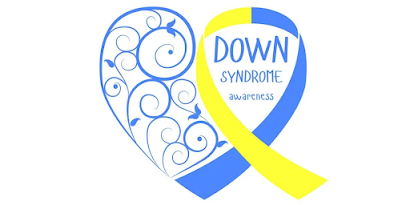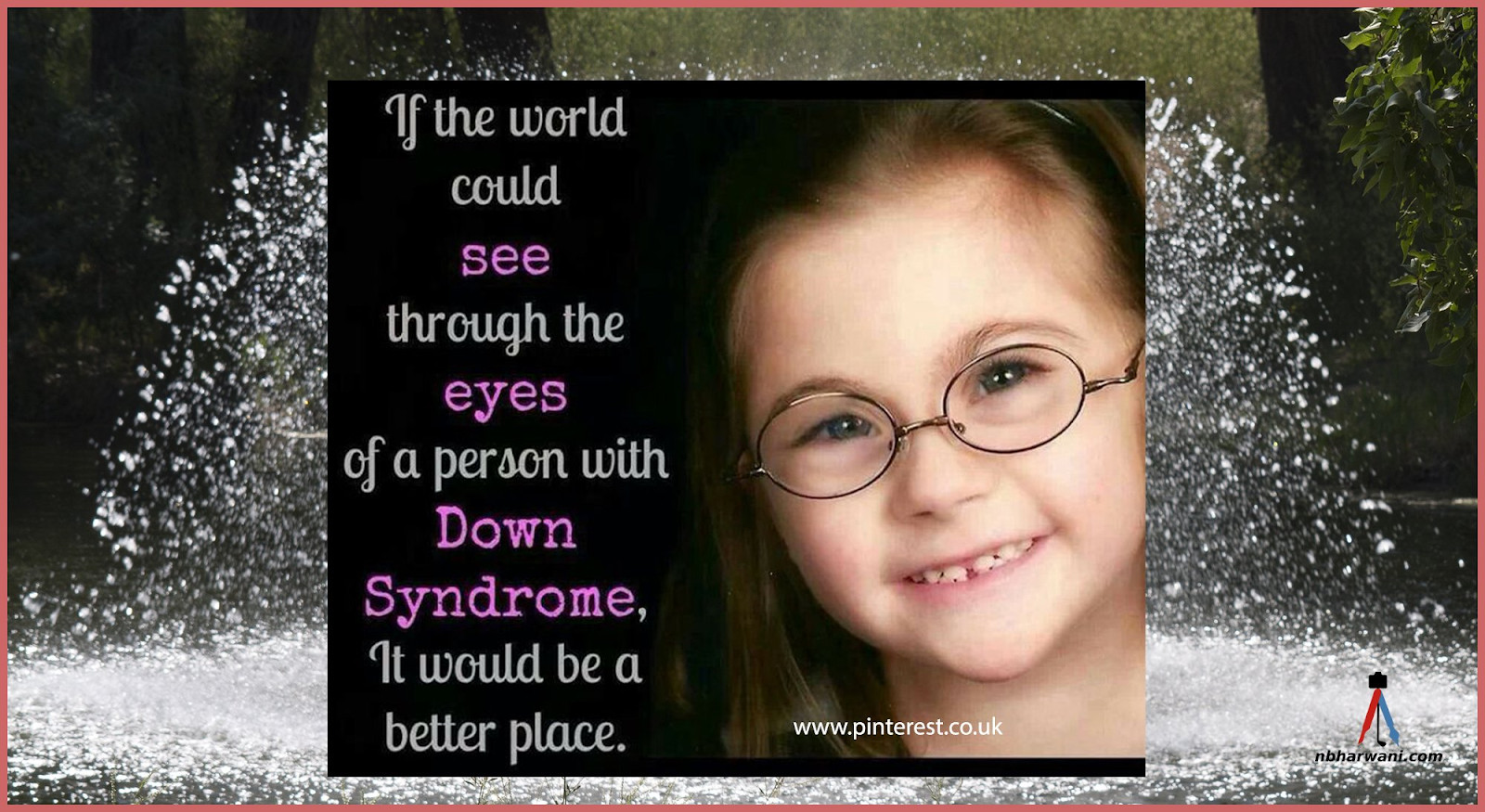Entry #4 - Down Syndrome
Yards are littered with spider webs, and zombies rise from their graves. Ghosts float amongst the trees while a black cat slinks around the alleyway. Screams and evil laughter fills the air as children skip around the neighborhood, excited for their next bag of candy. This is what the month of October is known for. However, October is also a month that we celebrate something far more special; October is a month that we celebrate something far more meaningful.
October is Down Syndrome Awareness Month! This is a very special time of year that has been set aside to help raise awareness of Down syndrome, why it occurs, and how it impacts the lives of children and adults alike. My little sister has Down syndrome, so I understand the challenges that can come with it, along with the blessings. Oftentimes, I feel like people have heard of Down syndrome but are not sure what it is. Down syndrome is NOT a disease, and it is NOT contagious. So what exactly is it?
To answer this question we have to take a brief look at how our genes work. We are all made of thousands upon thousands of tiny cells. Each cell contains a nucleus, and it is in this nucleus that our genes are carried. Our genes contain all of the genetic material that we inherit from our parents. These genes are stored in small chromosomes. Most of us have 46 individual chromosomes that combine into 23 pairs; however, children with Down syndrome are born with an extra copy of chromosome 21. We do not know exactly what causes this to happen, but we do know that the chances of having a child with Down syndrome increase with age. The National Down Syndrome Society says that, "a 35-year-old woman has about a 1 in 350 chance of conceiving a child with Down syndrome, and this chance increases gradually to 1 in 100 by age 40. At age 45 the incidence becomes approximately 1 in 30." Down syndrome is actually the most common chromosomal condition in the United States. Approximately 5,100 babies are born with Down syndrome each year in the U.S., meaning that 1 in 772 babies are born with Down syndrome (The National Down Syndrome Society).
(Above is a picture of chromosomes in which the 21st chromosome has an extra copy.)
There are three different types of Down syndrome, Trisomy 21, Translocation Down syndrome, and Mosaic Down syndrome. According to the CDC, Trisomy 21 occurs when someone has three copies of the 21st chromosome as opposed to the typical two. About 95% of people with Down Syndrome have Trisomy 21. About 3% have Translocation Down syndrome, which is when someone has an extra copy of the 21st chromosome but it is attached to another chromosome. Finally, there is Mosaic Down syndrome, which makes up the final 2%. Mosaic is caused when some of the cells have a third copy of the 21st chromosome, but other cells have the typical two copies.
Some physical attributes that typically appear in people with Down syndrome are a flat nose bridge, small hands and feet, almond shaped eyes that slant upward, one crease in the palm of their hand, a short neck, and shorter than average height. They may suffer from health conditions such as low muscle tone, ear infections, hearing loss, vision and dental problems, obstructive sleep apnea, heart issues, and they may be more susceptible to illness (Cleveland Clinic). My family has been extremely blessed in that my little sister does not have any severe health conditions, but there are many others who struggle with these issues.
Some activities and learning tasks can be harder for people with Down syndrome compared to their peers. Oftentimes, they have short attention spans and may struggle with memorization. Many, such as my sister, have trouble communicating with others, as well. Have you ever tried speaking with a mouthful of at least six jumbo marshmallows? It's a challenge, isn't it? That is what it is like for people with Down syndrome. My sister took speech therapy for many, many years, and one time her speech therapist explained that we often don't think a lot about the long process that communication goes through. When someone says something to my sister, she needs more time than her peers to process what was said. Then she has to think of a response, figure out how to say her response, and then she actually has to say it. It is a long, tiresome process, but if you are patient enough to wait she always has something witty, funny, or kind to say.
Sometimes, children with Down syndrome have behavioral issues. Down Syndrome Education International says:
Children with Down syndrome show higher rates (than typically developing children) of attention problems, social withdrawal, noncompliance, and compulsions (such as arranging objects and repeating certain actions) as well as high rates of self talk. With increasing age, behaviors associated with anxiety, depression, and withdrawal also increase. Finally, recent research has indicated a pervasive pattern in children with Down syndrome, present from infancy, of escape and attention motivated challenging behaviors involving noncompliance and misuse of social behaviors.
Children with Down syndrome see the world very differently than we do. Because they have trouble with speech it can be difficult for them to explain how they are feeling. When she was younger, my sister would throw very obvious tantrums in public, and we often could not understand what the problem was because she did not know how to communicate to us. People with Down syndrome also tend to rely on a consistent schedule. Whenever something changes from our schedule or from what we thought was going to happen, my sister tends to have small breakdowns. If something unexpected happens it is almost as if she doesn't know what to do, so she acts up. To the outside world, it looks as though she is just being mean or grouchy, but in reality she just struggles to process what has changed.
Despite the extra work that some activities take, people with Down syndrome are really not much different than you and I. My younger sister may struggle with speech, and she may be a little behind in school, but she still has the same thoughts, feelings, and dreams as any other teenage girl. She has likes and dislikes, hopes and fears. She adores watching the DC series The Flash, and she is obsessed with Barry Allen. She is an incredible swimmer, and she just recently won a gold and a silver medal in a Special Olympics swim meet. She cannot wait until the day that she will be able to drive, and she is determined that she will someday own a cat. She loves listening to music, singing, and dancing too. My sister has a deep desire to feel as though she belongs amongst her peers; a desire that many of us have, as well.
Just like other girls, my sister has a crazy range of emotions. She is not afraid to tell you when she is mad or doesn't like something, and I am often amazed at how easy she finds it to be honest, even if it is a little hurtful. When she is mad, she is often very quick to forgive others and puts it behind her. She has an incredible laugh and smile that always manages to make my day, and when I am sad or not feeling well she is right there asking me if I am okay. She sees the world in a very simple light that is beautiful and encouraging. Honestly, I cannot put into words just how amazing she is. I am extremely thankful to have her in my life, and I wouldn't have it any other way.
Down syndrome is a common condition that is caused when a baby is born with one extra chromosome. The extra chromosome can cause people with Down syndrome to have physical challenges. Children with Down syndrome may struggle to keep up with their peers in school because they may have difficulty processing information quickly or focusing for long amounts of time. Oftentimes, people with Down syndrome can have trouble communicating with others because things like speech is ten times harder for them than it is for their peers. However, Down syndrome is a condition that these people have, it is NOT WHO THEY ARE. With the right amount of patience, kindness, and love, we can touch these people's lives in ways unimaginable. They can overcome these challenges. My sister has Down syndrome, and she is one of the most amazing, beautiful, brave, strong, and talented people that I know. I have learned so much from her. I am truly blessed to have my little sister in my life.











Hi Yesmeen! You used lots of great information throughout your blog and all the information you used was needed. Before reading your post, I didn't know much about Down syndrome and I'm so glad I was able to read your post and learn so much. It's interesting to see how common Down syndrome is and how no one really knows the cause of it. Like you said Down syndrome is a condition and it's not who someone is so we should still treat everyone the same even if they do have challenges.
ReplyDeleteSorry, I forgot to add my name. This post was sent by Katie Borrego.
DeleteHi Yesmeen, this post was very beautiful and emotional. I didn't know it was Down Syndrome Awareness Month and am glad you made me aware. I don't have anyone close to me with Down Syndrome, but have a few friends in my church who are and they touch everyone's heart. You sound like an amazing sister to your sister and must have a lot of patience. It makes me sad thinking of how frustrating it must be for people with Down syndrome to communicate. Thank you for making me more aware!
DeleteGreat intro, you shifted the lens so quickly. I also like how you related it to yourself and your family, it really adds to the passion you have in this entry. You taught me a lot of things about down syndrome in this blog! I wasn’t aware that there were different forms of down syndrome or that people with down syndrome had physical attributes. Thank you!
ReplyDelete